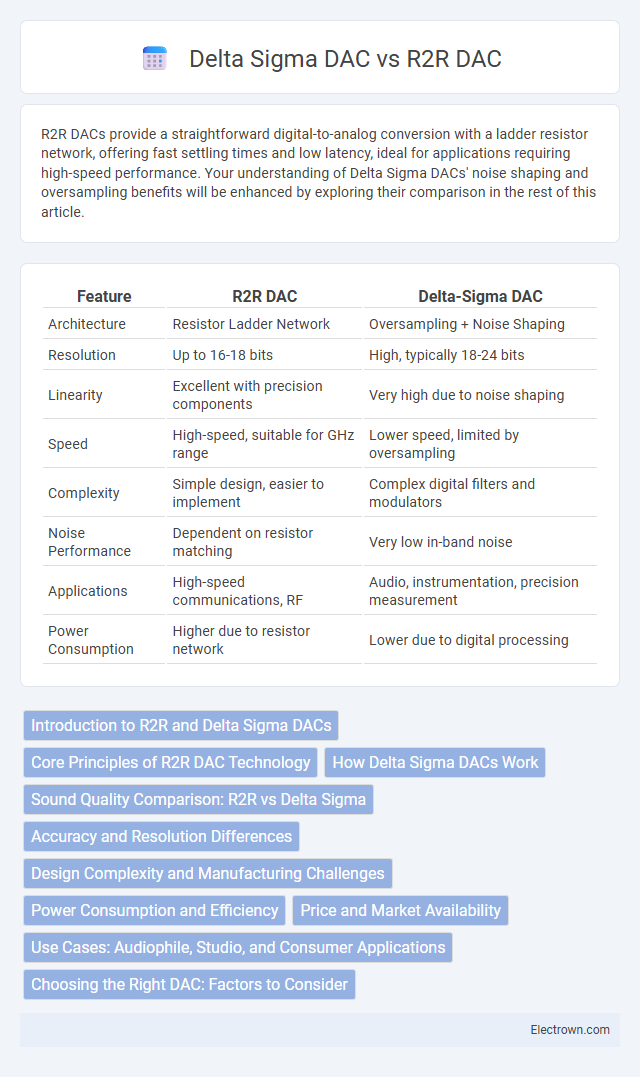R2R DACs provide a straightforward digital-to-analog conversion with a ladder resistor network, offering fast settling times and low latency, ideal for applications requiring high-speed performance. Your understanding of Delta Sigma DACs' noise shaping and oversampling benefits will be enhanced by exploring their comparison in the rest of this article.
Table of Comparison
| Feature | R2R DAC | Delta-Sigma DAC |
|---|---|---|
| Architecture | Resistor Ladder Network | Oversampling + Noise Shaping |
| Resolution | Up to 16-18 bits | High, typically 18-24 bits |
| Linearity | Excellent with precision components | Very high due to noise shaping |
| Speed | High-speed, suitable for GHz range | Lower speed, limited by oversampling |
| Complexity | Simple design, easier to implement | Complex digital filters and modulators |
| Noise Performance | Dependent on resistor matching | Very low in-band noise |
| Applications | High-speed communications, RF | Audio, instrumentation, precision measurement |
| Power Consumption | Higher due to resistor network | Lower due to digital processing |
Introduction to R2R and Delta Sigma DACs
R2R DACs use a resistor ladder network to convert digital signals to analog, offering fast conversion speeds and straightforward design suitable for high-frequency applications. Delta Sigma DACs employ oversampling and noise shaping techniques, achieving higher resolution and better linearity by pushing quantization noise out of the signal band. Both architectures serve distinct roles in digital-to-analog conversion, with R2R favored for speed and simplicity, while Delta Sigma emphasizes accuracy and low distortion.
Core Principles of R2R DAC Technology
R2R DAC technology operates on a resistor ladder network, leveraging precise resistor values to convert digital signals into analog voltages with minimal computational complexity. This architecture enables linear, monotonic conversion by summing weighted current contributions, offering low latency and high accuracy in applications requiring fast, real-time processing. Understanding these core principles helps you evaluate the suitability of R2R DACs for high-speed, high-fidelity audio and instrumentation systems compared to the noise-shaping benefits of delta-sigma DACs.
How Delta Sigma DACs Work
Delta Sigma DACs operate by oversampling the input signal and using noise shaping techniques to push quantization noise outside the audible frequency range. They convert the digital input into a high-frequency pulse density modulated bitstream, which is then filtered by an analog low-pass filter to retrieve the analog output. This process results in improved resolution and reduced distortion compared to traditional R2R DACs, especially at lower cost and complexity.
Sound Quality Comparison: R2R vs Delta Sigma
R2R DACs deliver superior sound quality characterized by a natural, analog warmth and minimal digital noise, making them ideal for audio purists seeking high-fidelity playback. Delta Sigma DACs excel in achieving higher resolution and dynamic range through oversampling and noise shaping, which results in lower distortion and a smoother frequency response. The choice between R2R and Delta Sigma DACs ultimately hinges on the listener's preference for either organic sound textures or precise, clean audio reproduction.
Accuracy and Resolution Differences
R2R DACs provide superior accuracy and linearity due to their resistor ladder architecture, reducing distortion and maintaining precise voltage levels. Delta Sigma DACs offer higher effective resolution through oversampling and noise shaping, pushing quantization noise out of the audible band. Your choice depends on whether you prioritize native accuracy (R2R) or enhanced resolution and noise performance (Delta Sigma).
Design Complexity and Manufacturing Challenges
R2R DACs feature a straightforward resistor ladder design but demand precision-matched resistors, posing significant manufacturing challenges to maintain accuracy and linearity. Delta-sigma DACs rely on intricate oversampling and noise shaping circuits, increasing design complexity with digital filtering and modulation requirements. Your choice depends on balancing the simpler hardware of R2R with the sophisticated signal processing of delta-sigma architectures.
Power Consumption and Efficiency
R2R DACs typically consume less power than delta sigma DACs due to their simpler architecture and direct digital-to-analog conversion process, making them more efficient for low-power applications. Delta sigma DACs use oversampling and noise shaping techniques that increase power consumption but provide higher resolution and better noise performance. Your choice depends on whether power efficiency or signal quality is the primary priority for your design.
Price and Market Availability
R2R DACs typically come with higher manufacturing costs due to precise resistor ladder networks, making them less affordable and less common in mass-market consumer devices compared to delta-sigma DACs. Delta-sigma DACs dominate the market with widespread availability and lower price points, benefiting from mature semiconductor processes and integration in many digital audio products. For your budget-conscious choice, delta-sigma DACs offer better market accessibility without compromising on overall performance.
Use Cases: Audiophile, Studio, and Consumer Applications
R2R DACs deliver precise, low-latency analog output, making them ideal for audiophile-grade headphones and high-fidelity studio monitoring where accuracy and sound purity are critical. Delta sigma DACs excel in consumer electronics like smartphones and streaming devices due to their superior noise shaping and cost-effective integration, providing smooth, distortion-free audio. Studio engineers often prefer delta sigma DACs for multichannel mixing consoles and digital audio workstations because of their flexibility and scalability across complex audio environments.
Choosing the Right DAC: Factors to Consider
When choosing between R-2R DACs and delta-sigma DACs, consider factors such as resolution, linearity, and noise performance, with R-2R DACs offering precise resistor ladder accuracy and delta-sigma DACs excelling in high-resolution and low-noise applications. Power consumption and speed also influence selection, where R-2R DACs typically provide faster conversion rates but higher power usage compared to the oversampling and noise-shaping techniques in delta-sigma DACs. The specific application requirements, including signal bandwidth, accuracy, and cost constraints, determine the optimal DAC architecture choice.
r2r dac vs delta sigma dac Infographic

 electrown.com
electrown.com